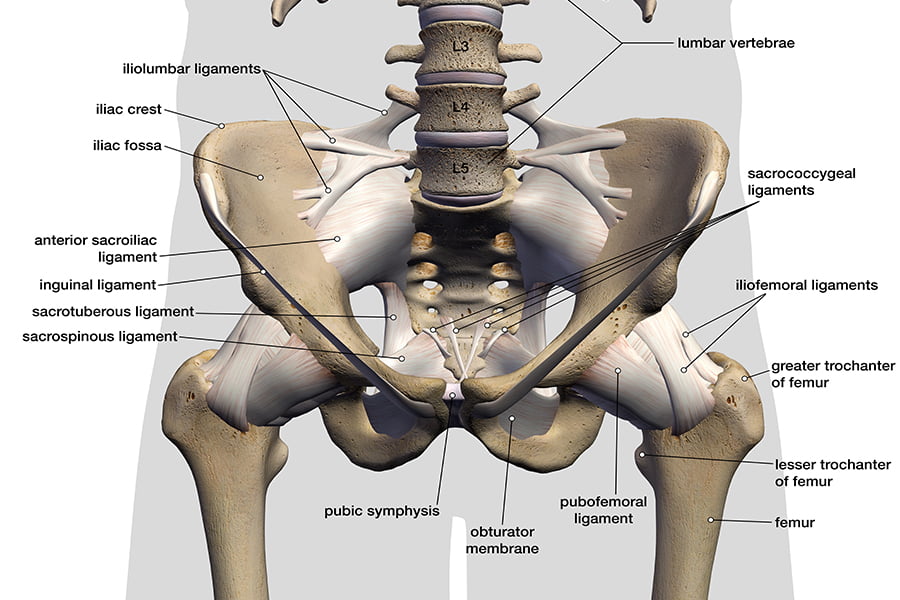
Hip pain treatment in Philadelphia
At Meeting Point Health, we offer a comprehensive selection of functional and regenerative treatments designed to meet a variety of health and performance needs.

TABLE OF CONTENTS

Regenerative Orthopedics for Tendonitis
The hip joint is a ball-and-socket joint connecting the femur and pelvis. It provides stability, supports upper body movement, and absorbs shock. The labrum, a layer of cartilage, cushions the joint, while the synovium lubricates it for smooth motion. Bursa sacs provide additional cushioning, and ligaments (iliofemoral, pubofemoral, and ischiofemoral) prevent hyperextension. Tendons, such as the iliotibial band, connect muscles to bones, allowing movement. Key muscles supporting the hip include the gluteals, adductors, iliopsoas, quadriceps, and hamstrings. This complex structure allows for flexibility and weight-bearing.
What are symptoms of a hip injury?
Localized or regional pain in the hip, groin, or buttock when resting or in motion
Swelling
Redness
Stiffness
Limited range of motion
Difficulty completing daily activities – walking, running, climbing stairs
“locking “ sensation
Click sound when in motion
Inflammation
What are common hip injuries?
Bursitis
Labral tear
Snapping hip syndrome
Femoroacetabular Impingement
Fractures
Dislocation
Osteoarthritis
Hip strains
Hip fracture
Avascular necrosis
Muscle strain
Hip instability
Hip dysplasia
Arthritis
Hip pointer
Strains
Abductor tear
Piriformis syndrome
Soft tissue injuries
Sports hernia
Osteitis pubis
Osteoarthritis is a chronic degenerative joint disease where the cartilage between the joints breaks down or tears. As time progresses, cartilage begins to weaken, becoming vulnerable to degeneration. Tears can then develop resulting in joint deterioration. Once the cartilage has eventually worn away, bone rubs against bone causing friction. To stabilize the joint without cartilage, bone spurs may begin to develop, which changes the shape of the bones in the joint. Bone spurs develop as the body’s way of protecting itself, however, they further hinder the range of motion and cause pain.
The development of osteoarthritis occurs gradually over time as cartilage begins to wear and tear. Several factors can increase the risk for osteoarthritis, such as:
- History of hip injury or surgery
- Age – risk increases with age
- Family history
- Overweight or obesity
- Medical history
- Genetics
Hip Bursitis is when the small, fluid-filled sac, known as the bursa, becomes inflamed. Bursae cushion bones, tendons, and muscles within a joint. Common sites of bursitis are the elbow, hip, and shoulder.
The primary cause of bursitis is the repetitive motions or positions that put strain on the bursae, such as lifting over the head or throwing a ball. In addition, trauma or injury could result in bursae, such as falling onto the hip or banging it onto a hard surface. Finally, hip inflammation, including rheumatoid arthritis or gout could progress to bursitis.
Anyone can develop hip bursitis, however, there are several risk factors:
- Age – the bursae become more vulnerable to degeneration with age
- An occupation that involves repetitive motions, such as construction or gardening
- Activities that involve repetitive motions, such as lifting or squatting
- Being overweight or obese
- History of injury or surgery to the area
A Labral tear in the hip happens when the labrum, which is the cartilage that surrounds the hip joint’s socket, tears. A labral tear is a common injury that has many causes, such as injury, trauma, and degeneration. Labral tears of the hip can be acute or occur gradually over time. An acute tear can result from contact sports, hip injuries, or trauma, such as falling. A gradual tear can develop due to repetitive motions or joint abnormalities. Athletes or jobs that require repetitive movements, such as dancing, running, lifting, or squatting are at higher risk of gradual onset. Hip abnormalities can also lead to tears, such as hip impingement. There is contact between the two bones of the joint, resulting in friction and stress on the cartilage. Another example would be hip dysplasia, where the hip’s acetabulum does not cover the femoral head completely, resulting in possible dislocation.
A labral tear can occur along two sides of the labral. An anterior labral tear develops at the front of the hip joint, while the posterior labral tears develop on the back of the joint.
If you’re experiencing any of these, it’s important to seek an evaluation to determine the best course of treatment. At Meeting Point Health, we specialize in personalized care to reduce pain, restore mobility, and prevent further damage. Call us today to request a consultation.
How to diagnose hip pain?
At Meeting Point Health, the first stage of treatment is assessment. We ask the question “What is the root cause of what you are experiencing?”. Dr. Stephen Matta will review the patient’s medical history, conduct a full physical examination, and perform ultrasound-guided imaging of the affected area. He will ask about the symptoms, the location and duration of the pain, limitations in joint mobility, and any previous injuries or medical conditions that may contribute to or result in joint degeneration. In addition, past medical records, recommendations, and imaging are reviewed when available. During the physical examination, Dr. Matta will observe simple movements, range of motion, and any discomfort within the joint. Finally, Dr. Matta will recommend a treatment plan.
How to treat a hip injury at Meeting Point Health
Don’t let hip pain and discomfort hold you back any longer! At Meeting Point Health, we specialize in personalized hip pain treatment plans tailored to your needs. Our experienced team is here to help you regain mobility and enjoy life to the fullest.
Visit Meeting Point Health today for hip pain treatment in Philadelphia. Schedule your consultation today and take the first step toward a pain-free future.
Osteopathic Manipulation Medicine is non-invasive, manual medicine that uses physical contact to manipulate bones, tissues, and muscles to relieve pain. Manipulation can include pressure and stretching to improve blood flow, range of movement, and motion. Dr. Matta often incorporates gua sha and cupping into this practice and regularly ends the session with acupuncture with electrostimulation.
Acupuncture involves the insertion of thin needles into specific points on the body to relieve pain and treat various musculoskeletal conditions. Acupuncture can improve chronic pain, acute injuries, and concerns with tendons, ligaments, joints, and connective tissue.
Nerve hydrodissection is a minimally invasive medical procedure involving injecting an anti-inflammatory solution around an entrapped nerve. Injectables such as dextrose, vitamins, peptides, plasma, procaine, and even stem cells are flooded around compressed or irritated nerves. This technique aims to separate the affected nerve from surrounding structures, such as muscles, fascia, or scar tissue, which may be contributing to the pain or dysfunction.
Prolotherapy therapy is a medical injection procedure whose goal is to relieve pain and promote healing of musculoskeletal conditions, especially involving ligaments, joints, and tendons Prolotherapy stimulates healing, causes inflammatory responses that increase blood flow and the arrival of immune cells and growth factors to the injection area, and tissue repair.
Prolozone therapy is a mixture of ozone gas and a prolotherapy solution is injected into the affected area, often around joints, ligaments, or tendons. The theory is that this combination not only irritates and strengthens the tissues (like prolotherapy) but also delivers the potential therapeutic benefits of ozone, such as improved circulation and tissue oxygenation. Prolozone combines procaine, dextrose, B vitamins, saline, oxygen, and ozone into a damaged joint and the combination allows for regrowth of damaged tissue.
Platelet-rich plasma PRP therapy is a medical treatment that involves the use of a patient’s own blood to promote healing and tissue regeneration. Once injected, the growth factors and other bioactive substances in PRP work to accelerate tissue repair, reduce inflammation, and promote the formation of new blood vessels. This helps in reducing pain, improving function, and enhancing the overall healing process.
Stem cell injection therapy refers to a medical procedure in which stem cells are harvested and then injected into a localized area on a patient’s body, typically to promote tissue repair, and regeneration, or to treat various medical conditions. Stem cells are unique because they can develop into different types of cells in the body, and they also have the capacity for self-renewal. This makes them valuable in medical treatments, as they can potentially replace or repair damaged or diseased tissues. Stem cell injection therapy can treat arthritic joints, sports injuries, tendinopathies, non-union fractures, meniscal tears, Degenerative Disc Disease, and Osteonecrosis or Avascular Necrosis.
Peptide Therapy can be introduced as an at-home treatment. Peptide therapy introduces peptides to signal communication with our cells to perform a specific response. Administrating peptides elicits a response to regulate or improve physiological functions. For regenerative medicine, peptides for wound recovery, and tissue repair, reduce inflammation, accelerate recovery time, and promote cell migration and differentiation.
If you’re experiencing any of these, it’s important to seek an evaluation to determine the best course of treatment. At Meeting Point Health, we specialize in personalized care to reduce pain, restore mobility, and prevent further damage.
Soul-Centered Healthcare As a Catalyst For Change
Many people suffer with undiagnosed or misdiagnosed conditions and simply don’t know what’s wrong with them or what will help. We understand what it’s like to feel trapped in a body that is not working for you! At Meeting Point Health, we find the root cause and use a proven, integrative approach that gets results. As highly trained pioneers in functional and regenerative medicine, we’ve helped thousands of patients take control of their health.
OUR PATIENTS FIND RELIEF HERE
Our Patients Find Relief Here
EXCELLENT
We’re here to answer all of your questions
Schedule a call with one of our onboarding specialists today so they can answer all of your questions.
Does Meeting Point Health accept insurance?
Meeting Point Health does not accept insurance.
Our practitioners and staff fully understand and empathize with the challenges that patients face as they make financial decisions for proper health care. Our practice is very different from a conventional medical practice in many ways, but the time spent with each patient is usually 30-90 minutes. Visits with a physician covered by insurance generally allow for less than 10 minutes in total! Conventional medical practices that take insurance maintain brief office visits and high patient loads for this reason. We cannot provide the expert care that every one of our patients deserves under those circumstances.
Insurance also dictates the types of treatments and order of treatments patients can receive for a particular condition.
Opting out of insurance allows the patient and the doctor to maintain their medical autonomy, which is imperative to ensure you get the right treatment at the right time and the right dose.
Can I get an insurance reimbursement?
How do I get started with Meeting Point Health?
To start your journey to relief, schedule a consultation with our team. During your initial visit, we’ll assess your medical history, perform a thorough evaluation, and develop a customized treatment plan to address your specific needs. Click to schedule a free discovery call with one of our Patient Onboarding Specialists today!

